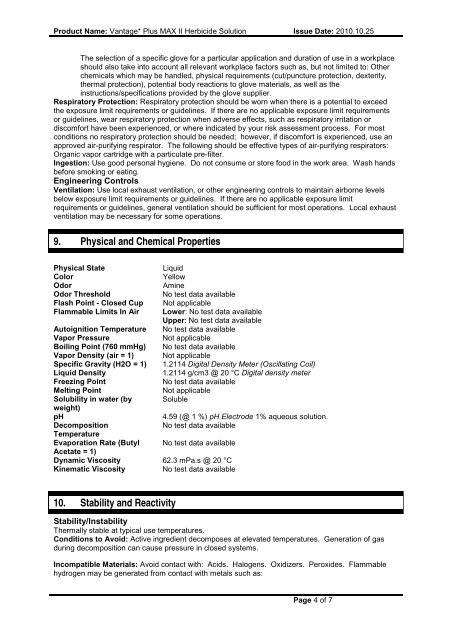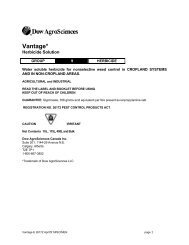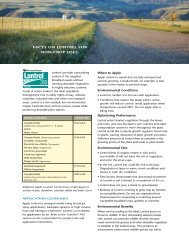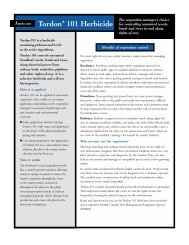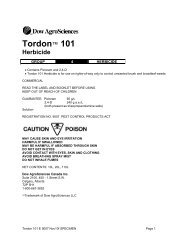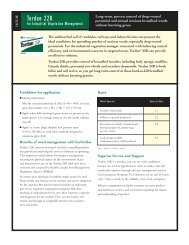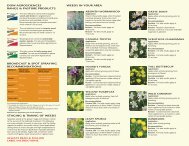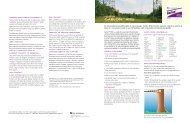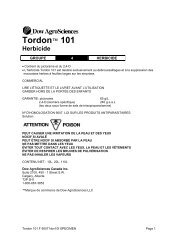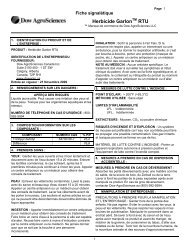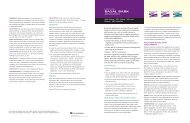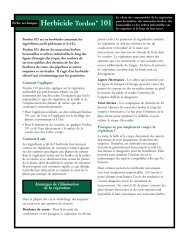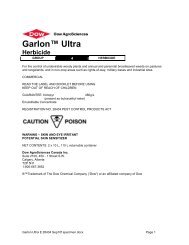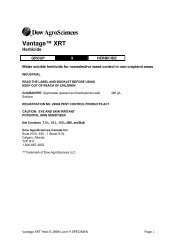Vantage⢠Plus Max II MSDS - True North Specialty Products
Vantage⢠Plus Max II MSDS - True North Specialty Products
Vantage⢠Plus Max II MSDS - True North Specialty Products
Create successful ePaper yourself
Turn your PDF publications into a flip-book with our unique Google optimized e-Paper software.
Product Name: Vantage* <strong>Plus</strong> MAX <strong>II</strong> Herbicide Solution Issue Date: 2010.10.25<br />
The selection of a specific glove for a particular application and duration of use in a workplace<br />
should also take into account all relevant workplace factors such as, but not limited to: Other<br />
chemicals which may be handled, physical requirements (cut/puncture protection, dexterity,<br />
thermal protection), potential body reactions to glove materials, as well as the<br />
instructions/specifications provided by the glove supplier.<br />
Respiratory Protection: Respiratory protection should be worn when there is a potential to exceed<br />
the exposure limit requirements or guidelines. If there are no applicable exposure limit requirements<br />
or guidelines, wear respiratory protection when adverse effects, such as respiratory irritation or<br />
discomfort have been experienced, or where indicated by your risk assessment process. For most<br />
conditions no respiratory protection should be needed; however, if discomfort is experienced, use an<br />
approved air-purifying respirator. The following should be effective types of air-purifying respirators:<br />
Organic vapor cartridge with a particulate pre-filter.<br />
Ingestion: Use good personal hygiene. Do not consume or store food in the work area. Wash hands<br />
before smoking or eating.<br />
Engineering Controls<br />
Ventilation: Use local exhaust ventilation, or other engineering controls to maintain airborne levels<br />
below exposure limit requirements or guidelines. If there are no applicable exposure limit<br />
requirements or guidelines, general ventilation should be sufficient for most operations. Local exhaust<br />
ventilation may be necessary for some operations.<br />
9. Physical and Chemical Properties<br />
Physical State<br />
Color<br />
Odor<br />
Odor Threshold<br />
Flash Point - Closed Cup<br />
Flammable Limits In Air<br />
Autoignition Temperature<br />
Vapor Pressure<br />
Boiling Point (760 mmHg)<br />
Vapor Density (air = 1)<br />
Specific Gravity (H2O = 1)<br />
Liquid Density<br />
Freezing Point<br />
Melting Point<br />
Solubility in water (by<br />
weight)<br />
pH<br />
Decomposition<br />
Temperature<br />
Evaporation Rate (Butyl No test data available<br />
Acetate = 1)<br />
Dynamic Viscosity 62.3 mPa.s @ 20 °C<br />
Kinematic Viscosity No test data available<br />
Liquid<br />
Yellow<br />
Amine<br />
No test data available<br />
Not applicable<br />
Lower: No test data available<br />
Upper: No test data available<br />
No test data available<br />
Not applicable<br />
No test data available<br />
Not applicable<br />
1.2114 Digital Density Meter (Oscillating Coil)<br />
1.2114 g/cm3 @ 20 °C Digital density meter<br />
No test data available<br />
Not applicable<br />
Soluble<br />
4.59 (@ 1 %) pH Electrode 1% aqueous solution.<br />
No test data available<br />
10. Stability and Reactivity<br />
Stability/Instability<br />
Thermally stable at typical use temperatures.<br />
Conditions to Avoid: Active ingredient decomposes at elevated temperatures. Generation of gas<br />
during decomposition can cause pressure in closed systems.<br />
Incompatible Materials: Avoid contact with: Acids. Halogens. Oxidizers. Peroxides. Flammable<br />
hydrogen may be generated from contact with metals such as:<br />
Page 4 of 7


